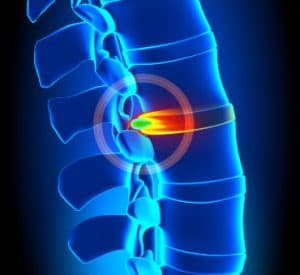What is a Herniated Disc?

- What Causes a Herniated Disc?
- What are Symptoms of a Herniated Disc?
- Can Herniated Discs be Prevented?
- What are Treatment Options for a Herniated Disc?
- What is the Expected Recovery Time?
- What is Rehabilitation Like for a Herniated Disc?
If you have ever seen an image or an x-ray of a spinal column you probably noticed that it is comprised of numerous discs. If you look closely, you’ll see the discs are all connected and appear to be stacked on top of each other. For a better idea of what a disc actually is, picture a jelly donut. It has a very soft middle, or center, that is encased by a harder outside layer.
This is similar to a disc in your spine. The jelly-like substance on the inside acts like a cushion to provide protection. A herniated disc occurs when this soft, jelly-like interior pushes through to the outside of the disc – like jelly that has escaped the center of your donut.
Most herniated disc occur in the lower back, although can also occur in your neck. You can have a herniated disc without knowing it. Only a physician can diagnose a herniated disc. If you suspect you are suffering from this condition, visit an Orlando orthopedic surgeon for treatment options.
What Causes a Herniated Disc?
A herniated disc occurs when a spinal disc looses elasticity & ruptures, expanding beyond its intended boundary. A herniated disc is most often a result of a gradual age related wear and tear commonly referred to as disc degeneration. This means the discs lose some water content (jelly) thus losing flexibility and are more likely to tear or rupture – even under minor pressure. Most of the time, people do not know exactly when the disc became damaged. For some, herniated discs occur with improper lifting or twisting the back when lifting an object. Very rarely a herniated disc can be the result of a traumatic event like a fall.
What are Symptoms of a Herniated Disc?
For many people, there are no apparent symptoms associated with a herniated disc. But as the disc begins to put pressure on a nerve, then there can be any number of symptoms. Some of the possible symptoms include:
- Lower back pain
- Pain that shoots down the hip and leg; even to the ankle or foot
- Numbness or a tingling feeling in one leg
- Muscle spasms or deep muscular pains
- Weakness in one or both of the legs
Can Herniated Discs be Prevented?
One of the primary causes of herniated discs is the loss of water content as we age. This shrinkage of discs is part of the natural aging process, which cannot be prevented. However, there are a few things that can be done to help prevent herniated discs in some people.
- Always lift properly using the legs and not the back, and do not hold your breathe with lifting
- Avoid smoking altogether
- Maintain a healthy weight
- Avoid performing strenuous activities on a regular basis
What are Treatment Options for a Herniated Disc?
Treatment options are varied depending on the nature of the herniated disc and its severity. Physicians may recommend either surgical or non-surgical treatment options depending on your individual diagnosis.
Non-surgical treatment options for herniated discs may include:
- Rehabilitation to work on pain control, strengthening exercises, flexibility and proper body mechanics
- Various medications to help decrease pain and inflammation, muscle relaxants and analgesics
- Use of ice or heat throughout the day
It is highly likely that the surgeon or physician will ask a patient to limit physical activities requiring bending or lifting. A patient may also be instructed on how to sit, stand and lift properly; or they may also learn some exercises that can help strengthen the muscles in the back and abdomen. In some cases, spinal surgeons may inject cortisone-type drugs to help alleviate nerve irritation.
In cases where a disc is fragmented and a piece becomes lodged in the spinal canal, surgery may be required to remove it. Depending on the severity, position and size of a herniated disc, surgeons may choose a variety of operations ranging in complexity. Many of these surgeries are minimally invasive and patients are back to work within just a few weeks.
What is the Expected Recovery Time?
Recovery time can vary from one patient to another and it depends largely on some specific factors including:
- Location of the herniated disc
- Severity of disc degeneration
- Severity of nerve compression
- Longevity of symptoms
- Specific treatment plan
In mild cases, symptoms can be alleviated within weeks with ice or heat, over-the-counter pain medications, flexibility exercises and proper lifting techniques. Some minor adjustments such as using good posture, using proper lifting techniques and ergonomic chairs can help reduce or eliminate the pain. For moderate cases, recovery can take quite a bit longer, up to six weeks or longer. In these cases, the physician may prescribe rehabilitation, medicines to control pain, steroid injections and rest. For more severe cases, recovery can take much longer since they require surgical interventions. Orthopedic surgeons utilize minimally invasive procedures to help shorten recovery time for most individuals.
What is Rehabilitation Like for a Herniated Disc?
Rehabilitation may be an option used prior to surgery as it can be beneficial for decreasing pain, increasing flexibility and muscle strength, and educating patients in proper body mechanics /lifting techniques for activities of daily living. Rehabilitation may also be required after the procedure to help strengthen the spine, increase flexibility and regain mobility. The surgeon may recommend varying lengths of rehabilitation depending on the severity of the condition prior to surgery. How long the condition existed before the surgical procedure can also have a bearing on an individual’s recovery time and needed therapy.


